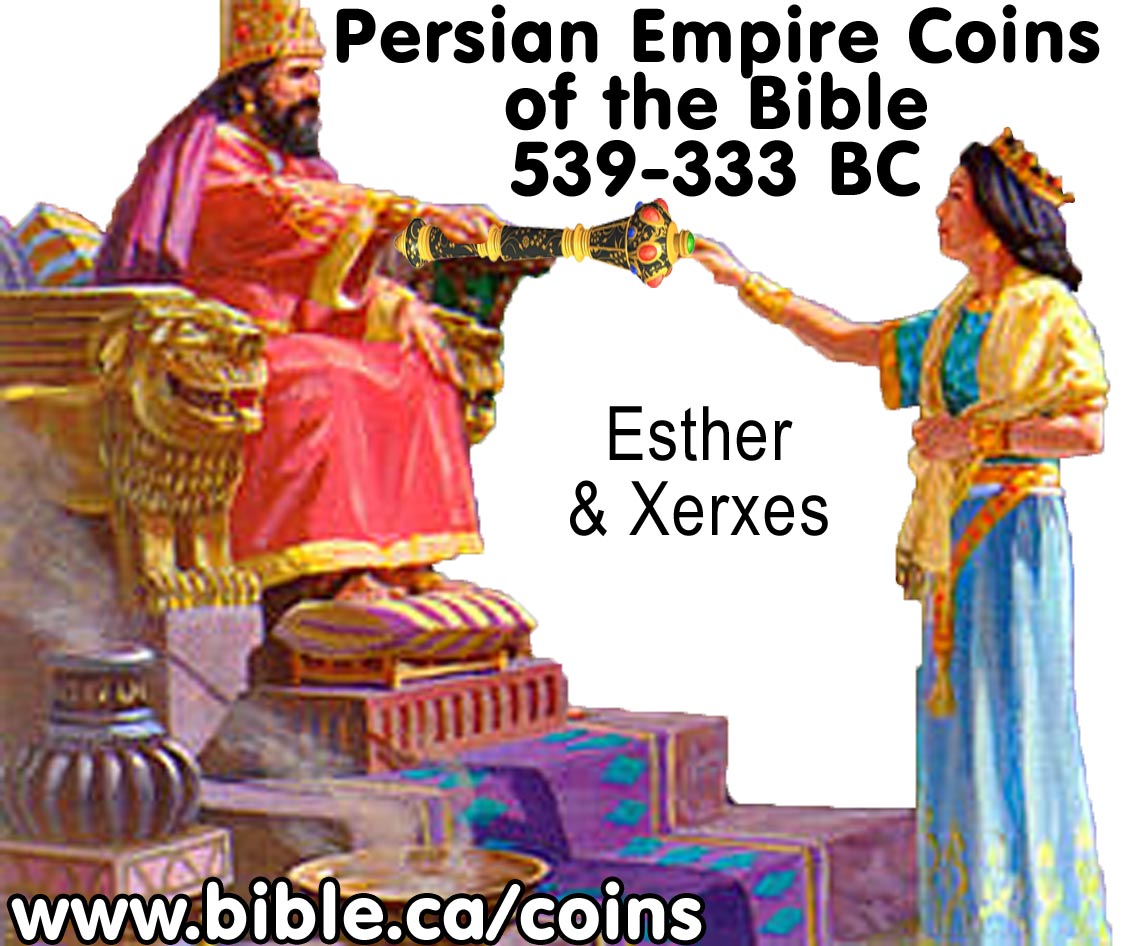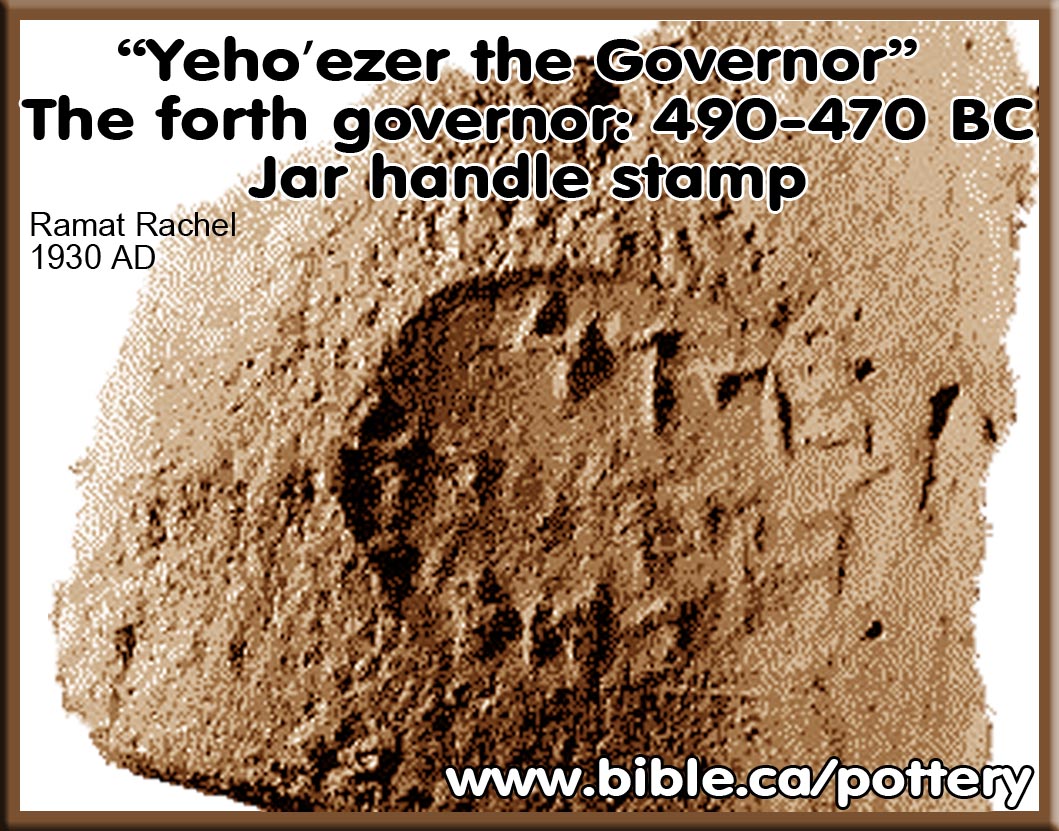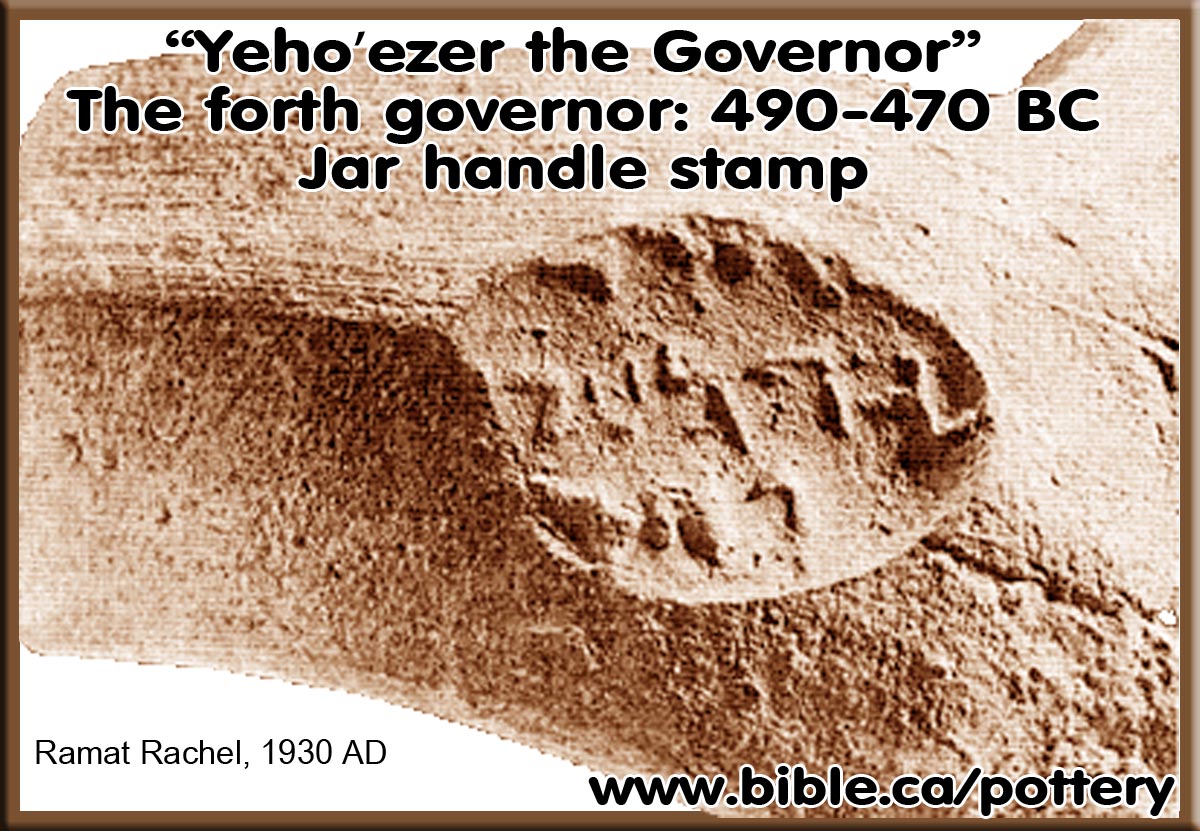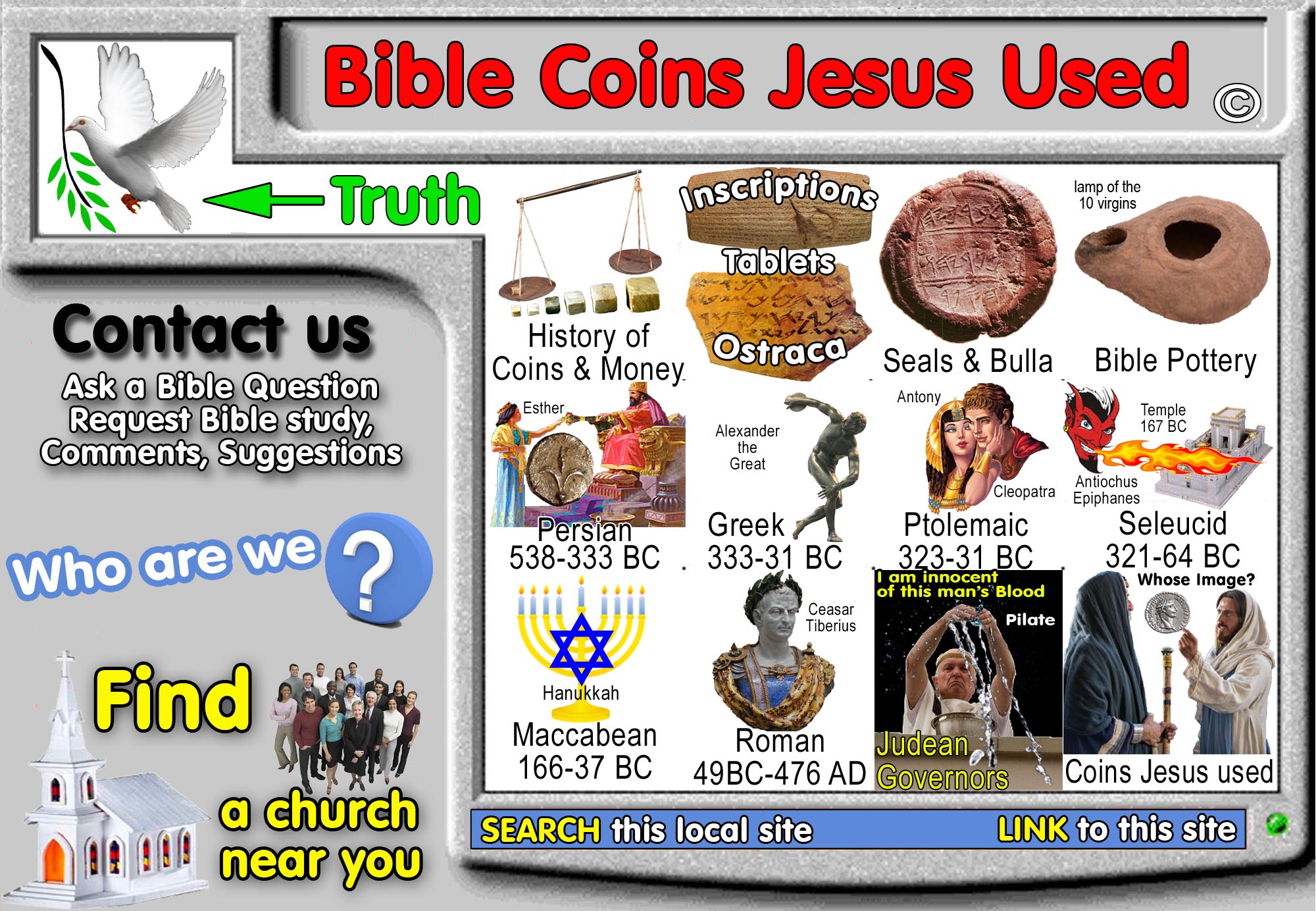Persian Empire Bible Coins: 539-333BC
Coins of the Persian appointed Satraps, Governors of Judah
|
Hebrew, Jewish, Yehuda, Bible coins of the Persian Empire 539-333BC
Persian Governors, Satraps of Judea |
Introduction:
- The first coins minted and used in Israel were produced during the Persian Empire.
- Esther lived in the middle of the Persian era and married King Xerxes (485-465 BC) and is therefore a fitting symbol for the entire Persian empire that dates from 539-333BC.
- Coins and pottery from the Persian era not only confirm details revealed in the Bible, they sometimes give us some important information about the Judean governors and other details, that are not revealed in the Bible!
- The King of Persia had appointed a "prince" or "governor" from among the returning Jews.
- The Bible gives us great details about three of the most famous Persian appointed governors of Judea, Sheshbazzar, Zerubbabel and Nehemiah.
- Five of the first eight governors of Judah are known only through archeology!
- Three unique words were brought into the Bible for the first time after the Babylonian captivity of 587BC and during the Persian Empire:
- "Yehudim" (Jew) is the unique word for the Jews is in the Bible after the Babylonian captivity and the Persian era.
- "Yehud" (Judah) is a unique Persian word found 6 times in the Bible.
- "Tirshatha" (Governor) A unique Persian origin word for governors (ie. Nehemiah) appointed by the Persian king is in the Bible. "pehah"= (Governor) is the standard Hebrew title of a governor that dates back to Solomon. However, during the minting of coins during Persian rule were inscriptions with "PHH" and sometimes additionally with the personal name of the governor!
- Several unique inscriptions from the Persian era and later have been found on coins, pottery and manuscripts.
- YHD unvowelled (or "YHWD" in vowelled script) is derived directly from JEW and/or JUDAH as referring to the entire Persian province.
I. Earliest and first Hebrew coins ever minted: Persian before 333BC
II. Persian appointed Jewish governors/princes of the province of Judah:
- Sheshbazzar: The first governor: 533-520 BC
- The decree of Cyrus in Ezra 1:1 happened in 539 BC. Five years later Sheshbazzar and Zerubbabel leave for Jerusalem
- "Also King Cyrus brought out the articles of the house of the Lord, which Nebuchadnezzar had carried away from Jerusalem and put in the house of his gods; and Cyrus, king of Persia, had them brought out by the hand of Mithredath the treasurer, and he counted them out to Sheshbazzar, the prince of Judah." (Ezra 1:7–8)
- "‘Also the gold and silver utensils of the house of God which Nebuchadnezzar had taken from the temple in Jerusalem, and brought them to the temple of Babylon, these King Cyrus took from the temple of Babylon and they were given to one whose name was Sheshbazzar, whom he had appointed governor." (Ezra 5:14)
- Zerubbabel: The second governor: 520-510 BC
- Both Sheshbazzar and Zerubbabel are said to lay the foundations of the Temple:
- "Then that Sheshbazzar came and laid the foundations of the house of God in Jerusalem; and from then until now it has been under construction and it is not yet completed.’" (Ezra 5:16)
- "Now in the second year of their coming to the house of God at Jerusalem in the second month, Zerubbabel the son of Shealtiel and Jeshua the son of Jozadak and the rest of their brothers the priests and the Levites, and all who came from the captivity to Jerusalem, began the work and appointed the Levites from twenty years and older to oversee the work of the house of the Lord. Then Jeshua with his sons and brothers stood united with Kadmiel and his sons, the sons of Judah and the sons of Henadad with their sons and brothers the Levites, to oversee the workmen in the temple of God. Now when the builders had laid the foundation of the temple of the Lord, the priests stood in their apparel with trumpets, and the Levites, the sons of Asaph, with cymbals, to praise the Lord according to the directions of King David of Israel." (Ezra 3:8–10)
- The solution is simple: When Sheshbazzar was the Governor, Zerubbabel was a high ranking official. Think of Moses and Joshua, Elijah and Elisha etc. Both were present at the laying of the foundation. When Sheshbazzar died, Zerubbabel succeeded him as Governor of Judah.
- Elnathan The third governor: 510-490 BC
- Archeology has found two bullas and seals with "phwʾ" with the name of Elnathan on them.
- The first has an inscription with “Belonging to Elnathan the governor” on it.
- The second is called the Shelomith seal with this
inscription on it: “Belonging to Shelomith, maidservant of Elnathan
the governor.”

- He is not mentioned in the Bible.
- This is an excellent example of where archeology can fill
in gaps of information the Bible lacks. This of course, does not take
away from the inspiration of the bible, since there are many facts of
history the Bible does not contain. However, any time the Bible does
touch upon history it is always right 100% of the time!
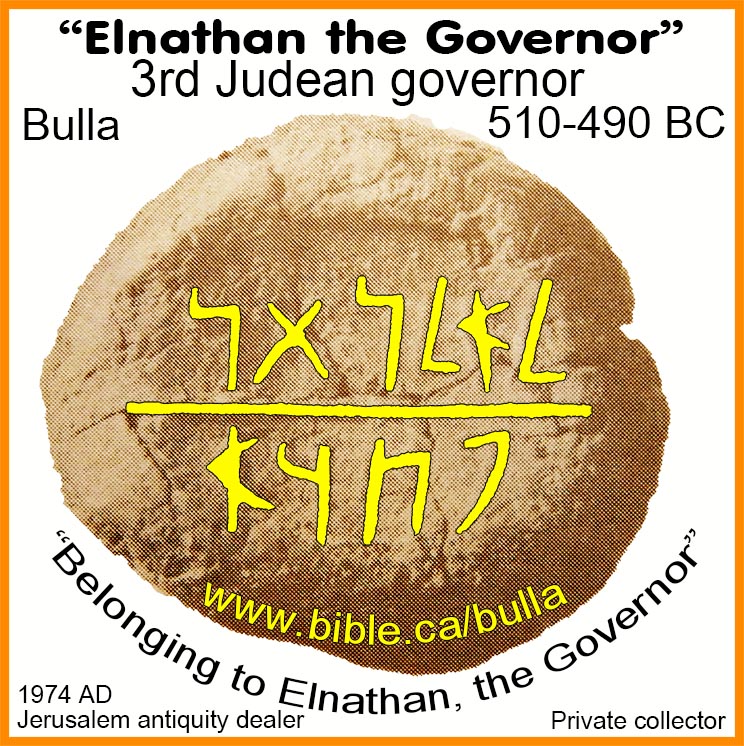


- Yehoʿezer: The forth governor: 490-470 BC
- Archeology has found a jar handle stamp impression with "phwʾ" on it and his name: “Yeho’ezer the Governor”
- He is not mentioned in the Bible
- However, excavations at Ramat Rachel in 1930 AD uncovered: "Another 130 seal impressions on jar handles found this season bring the total to 400. About 50 belong to the Iron Age and the rest to the Persian period" (Excavations at Ramat Racḥel, Yohanan Aharoni, Biblical Archaeologist, Vol 24, 1961 AD)
- Ahzai: The fifth governor: 470-460 BC
- Archeology has found a jar impression with "phwʾ" on it.
- Nehemiah: The Seventh governor: First term: 445-433 BC (20th -32nd year of Artaxerxes I who reigned 464-424BC) Second term: 429-? BC
- Ezra: Arrives in Jerusalem in 458 BC in the 7th year of Artaxerxes I, which is 13 years before Nehemiah arrives in 445 BC
- "Moreover, from the day that I [Nehemiah who is writing the book] was appointed to be their governor in the land of Judah, from the twentieth year to the thirty-second year of King Artaxerxes, for twelve years, neither I nor my kinsmen have eaten the governor’s food allowance. But the former governors who were before me laid burdens on the people and took from them bread and wine besides forty shekels of silver; even their servants domineered the people. But I did not do so because of the fear of God." (Nehemiah 5:14–15)
- "Then Nehemiah, who was the governor, and Ezra the priest and scribe, and the Levites who taught the people said to all the people, “This day is holy to the Lord your God; do not mourn or weep.” For all the people were weeping when they heard the words of the law." (Nehemiah 8:9)
- Sanballat and Tobiah opposed Nehemiah in 445 BC in Neh 2:10
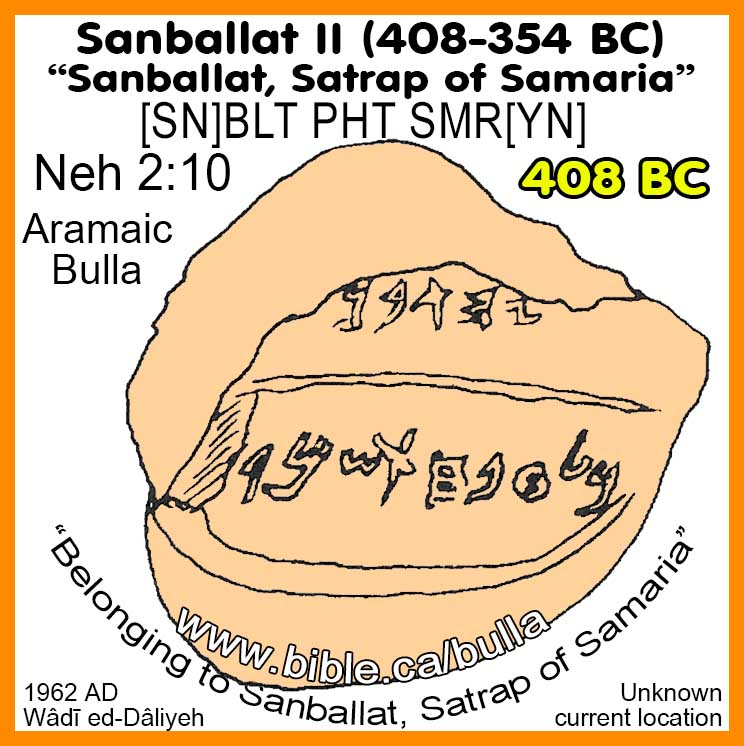
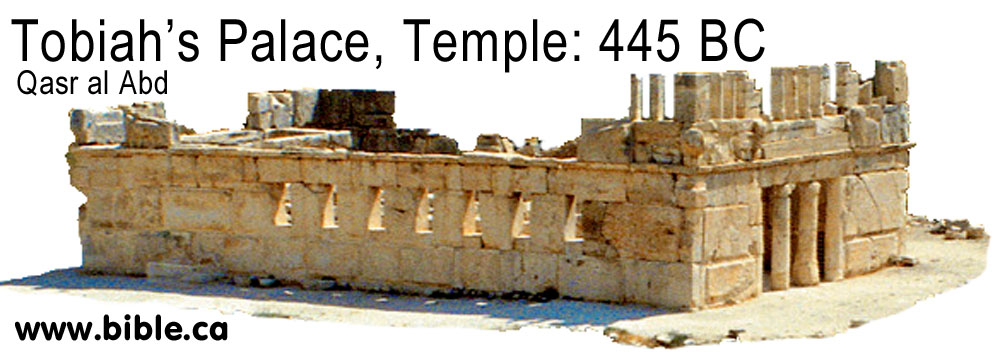
- "Aramaic dedication inscription of Qaynu son of
Gashmu, king of Qedar, on a silver bowl from Tell el-Mashkhuta, Egypt.
Four of the silver bowls bear Aramaic dedicatory inscriptions to the
goddess Han-Ilat. One of the inscriptions reads: “That which Qaynu, son
of Gashmu, king of Qedar, brought in offering to Han-Ilat.” An analysis
of the bowls and their inscriptions has led scholars to conclude that the
Gashmu mentioned in the inscription is the very same Gashmu (or Geshem)
mentioned in Nehemiah 2:19, 6:1,2,6." (Gashmu, Nehemiah’s Adversary
, Bible and Spade, Vol 1, No 3, p82, 1972 AD)

- Bagohi: The sixth governor: 409 BC
- Archeology has found the Persian Elephantine Papyus with "Bagohi the satrap of Judah" and "Sanballat satrap of Samaria" in the text of the same "Temple Papyri" letter.
- This is the only reference to Bagohi we have and we would not know about him if we did not have the 28 Elephantine Papyrus discovered in 1904 BC
- More on the
Elephantine Papyrus.
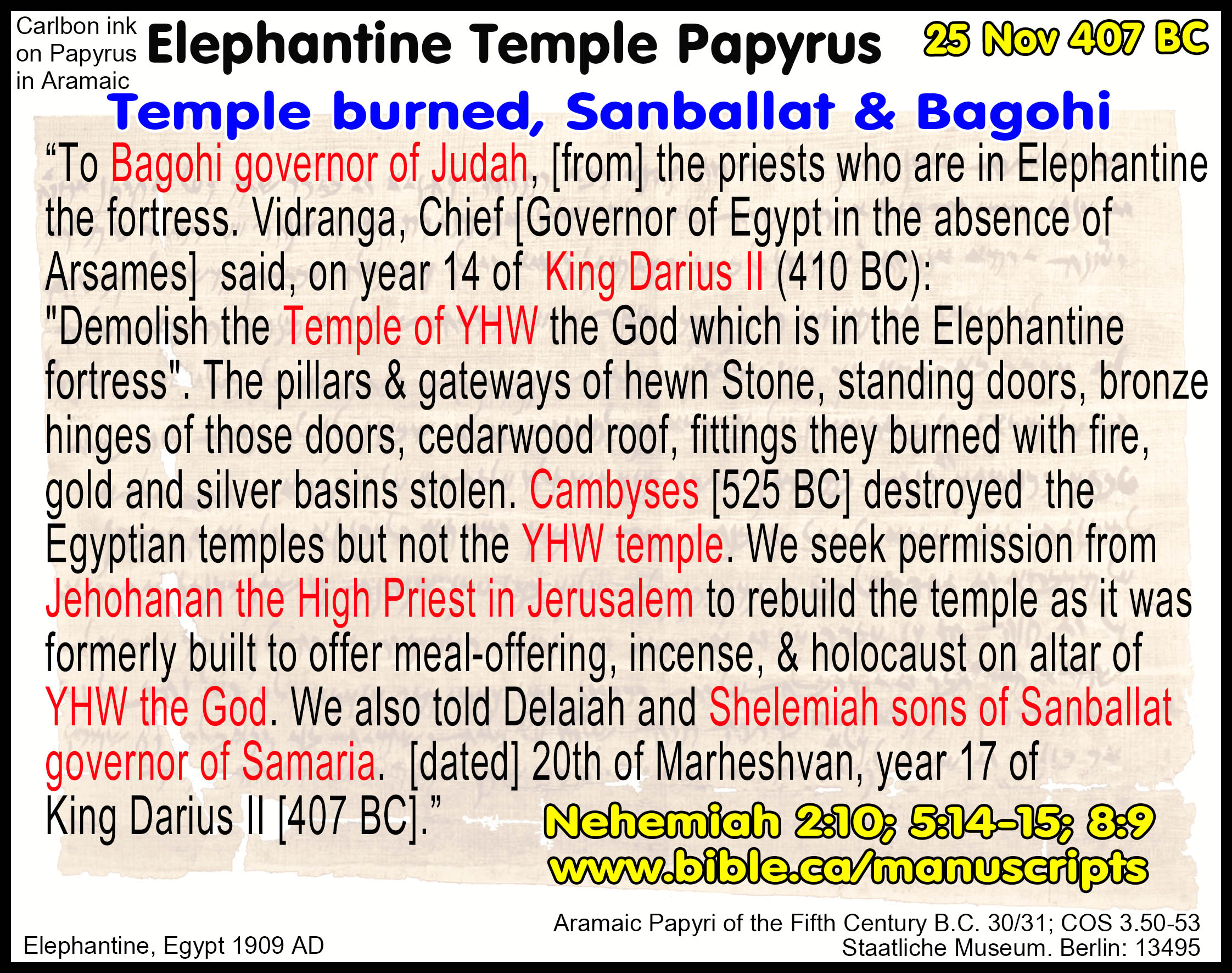
- "Hezekiah": Governor of Judea: 350-302 BC
- Hezekiah was the last governor of the Persian Empire and governed after Alexander the Great started the Greek empire in 333BC.
- Hezekiah, therefore, is unique in that he governed Judea through the transitional period between the Persian and Greek empires.
- Archeology has found two coins with his name as governor.
- We know about him only through coins he minted
- Some coins contained the full inscription naming Hezekiah as the governor: "YHZQKYH HPHH" (Yehezqiyah the Satrap) (Meshorer: Coins 22-23);
- Others, like this one, "YHZQYH" (Yehezqiyah) (Meshorer: Coins 24-26) only mention Hezekiah without the PHH (Hebrew: Peheh)
- See the page on Yehezqiyah
"Hezekiah" for more details on his coin!
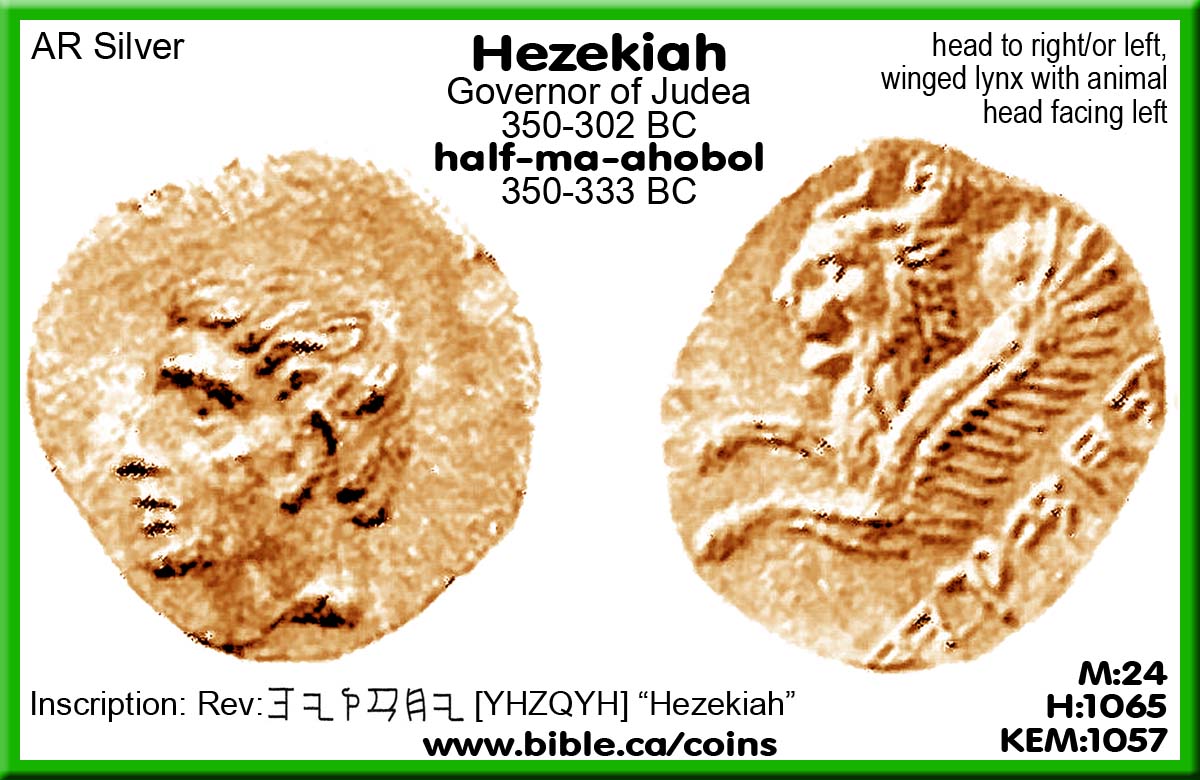
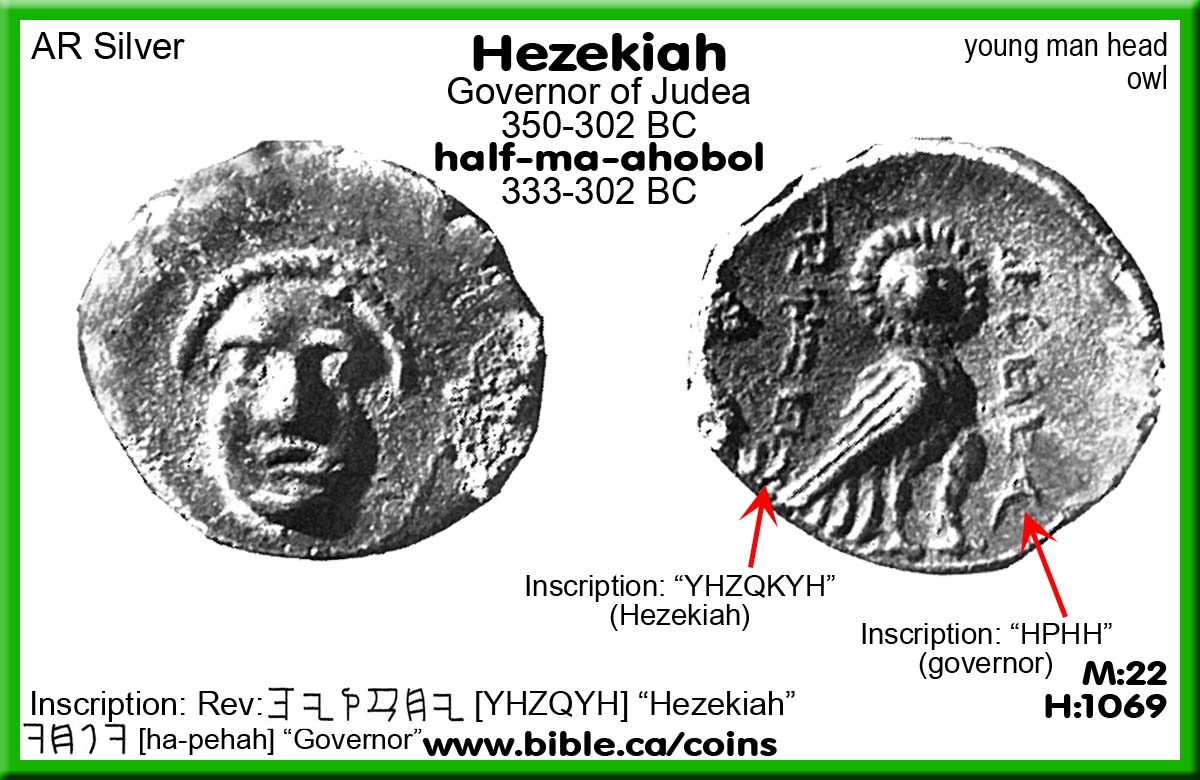
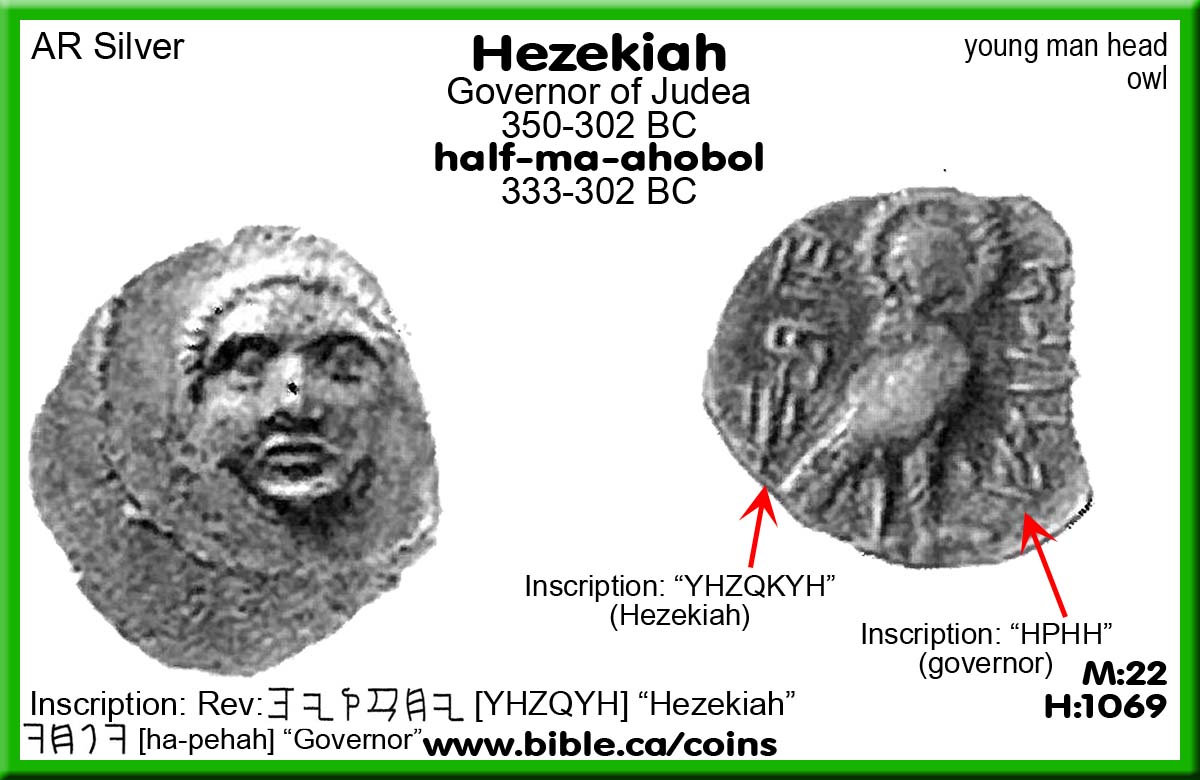
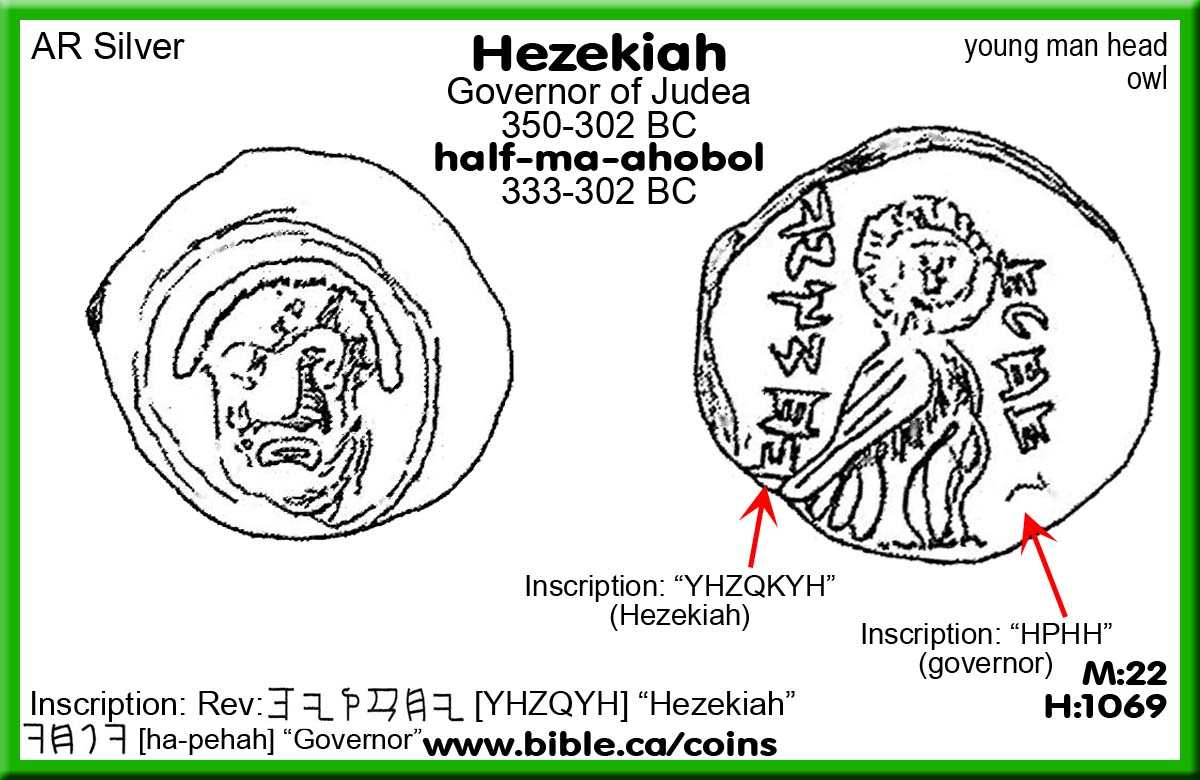
III. "Yehudim" (JEW) was first applied to the Hebrews during the Babylonian captivity:
- Jew: The Hebrew people were first called "Yehudim" (Jews) by the Babylonians and Persians.
- Yehudim = Literally=one of the tribe Judah = usage is "Jew" as today, one who ascribes to Judaism and the law of Moses.
- "Although Heb. yehűḏî means “person belonging to [the tribe of] Judah,” it is never used this way in the OT. It comes into prominence only after the destruction of the northern kingdom and, more specifically, after the Babylonian Captivity. Thus it is used of an Israelite living in the province of Judea (Judah) during the Babylonian, Persian, Greek, and Roman periods. It is most frequent in Esther, where it denotes all Israelites (cf. the application of the term to Mordecai, who was of the tribe of Benjamin: 2:5; 3:5; 5:13; etc.); the same usage is found in Daniel (3:8, 12). Hence the term takes on a decidedly religious connotation, referring to adherents of the Hebrew religion (see Judaism), though there often remains a close connection with the land of Judah. (ISBE, Jew, 1988 AD)
- Abraham was first to be called a "Hebrew" (Gen 14:13) and the exile Hebrews were first to be called "Jews" (2 Kings 25:25).
i. "Then a fugitive came and told Abram the Hebrew. Now he was living by the oaks of Mamre the Amorite, brother of Eshcol and brother of Aner, and these were allies with Abram." (Genesis 14:13)
- Yehudim is a unique word in the Old Testament the Babylonians and Persians used to refer to the Hebrew population from Judah.
- The word "Jew" is common today but no one in the Bible before the Babylonian Captivity of 587 BC was ever called a JEW.
- JEW and Christian were names enemies gave the people of God.
- The first time any Hebrew was called a Jew is after the Babylonian captivity of 587 BC:
i. "But it came about in the seventh month, that Ishmael the son of Nethaniah, the son of Elishama, of the royal family, came with ten men and struck Gedaliah down so that he died along with the Jews [literally: Yehudim] and the Chaldeans who were with him at Mizpah." (2 Kings 25:25)
- The first time JEW is used in Ezra, was by the enemies of the Hebrews in a letter to the king of Persia. This confirms it is a foreign label given to the people of God.
i. "let it be known to the king that the Jews [literally: Yehudim] who came up from you have come to us at Jerusalem; they are rebuilding the rebellious and evil city and are finishing the walls and repairing the foundations." (Ezra 4:12)
- In the New Testament, it appears that "Christian" (Acts 12:26; 26:28) like "Jew" were names given the people of God by unbelievers!
- There are no inscriptions on coins with JEW on them, but YHD came to represent both the people (Jews, yehudim) and the province (Judah, Yehud).
IV. "Yehud" (land of Judah) is a unique Persian origin word for the territory of the province of Judah
- "YHD" inscriptions on coins represent primarily the three letter symbol for the Persian PROVINCE of Judah and secondarily as the people who became known as "Jews".
- After the Persian period ended with Alexander the Great in 333 BC, the YHD continued to be minted on Hebrew coins till about 200 BC.
- Eventually the YHD was replace with "YRSLM" around 200 BC.
- "The literary sources from the time of the Return to Zion do not mention that Jerusalem was called "YHD," but seal impressions found on jar handles from the Persian and Hellenistic periods suggest that this was the case. It has become evident that Judean jar handles from the beginning of the second century B.C.E. bear the inscription "YRSLM." The name "YRSLM" thus came to replace the term "YHD" (depicted on the earlier jar handles) which probably had also applied to the city." (Hendin, p6)
- "YEHUD" is a unique Persian form of the word for Judah (Jehudah).
- The standard word in the Old Testament for Judah is "Yehudah" which is found 819 times.
- Persian "Yehud" (6 times) is equivalent to "Yehudah" (819 times)
- Persian "Yehud is found only 6 times in the Bible during the Persian era: Ezra 5:1; 5:8; 7:14; Daniel 2:25; 5:13; 6:13
i. "Now the prophets, Haggai and Zechariah son of Iddo, prophesied to the Jews who were in Judah [Persian: "Yehud"] and Jerusalem, in the name of the God of Israel who was over them." (Ezra 5:1)
ii. "May it be known to the king that we went to the province of Judah [Persian: "Yehud"], to the house of the great God. It is being built of hewn stone, and timber is laid in the walls; this work is being done diligently and prospers in their hands." (Ezra 5:8)
iii. "For you are sent by the king and his seven counselors to make inquiries about Judah [Persian: "Yehud"] and Jerusalem according to the law of your God, which is in your hand," (Ezra 7:14)
iv. "Then Arioch quickly brought Daniel before the king and said to him: “I have found among the exiles from Judah [Persian: "Yehud"] a man who can tell the king the interpretation.”" (Daniel 2:25)
v. "Then Daniel was brought in before the king. The king said to Daniel, “So you are Daniel, one of the exiles of Judah [Persian: "Yehud"], whom my father the king brought from Judah?" (Daniel 5:13)
vi. "Then they responded to the king, “Daniel, one of the exiles from Judah [Persian: "Yehud"], pays no attention to you, O king, or to the interdict you have signed, but he is saying his prayers three times a day.”" (Daniel 6:13)
- "The name Yehud (Persian for Judah) was struck on at least two Philistian quarter-sheqels (Nos. 1045 and 1046) and the initial yod, its first letter, was struck on both quarter-sheqels and ma `ah-obols (Nos. 1047, 1048). These coins were manufactured on the Philistian weight standards, and in design and fabric resemble the Philistian coins and not the Yehud issues struck later and used in and around the Jerusalem area. One coin, No. 1049, possibly a quarter-sheqel, is of special interest because it relates to the Judaean weight standard, and it carries the name yhwd in four letters along with the 0 (` ayin), one of the traditional mintmarks of Gaza. This clue suggests that the earliest series of Yehud coins, all of which are either unique or extremely rare, may have been struck at Gaza for use in Judah, and later a mint was established in the Jerusalem area. Gitler and Tal have noted that both generic "Philistian" and specific coins of Gaza were minted at the same mint 18 Gitler also confirms that there is now additional evidence for the increased probability of an initial central mint in Philistia." (Hendin, p87)
- "The eponym of the tribe of Judah was born to Jacob as his fourth son by his wife Leah (Gen 29:35). In Akkadian sources we find the name forms ya-á-du, ya-a-ḫu-du and ya-ku-du. This is similar to the yĕhűd or yahűd from the Persian period. An inscription found in a rock-cut tomb in W Judah, that most probably dates back to the 7th or 6th century b.c.e., has hry yhd, “the mountains of Judah.” On Arad Ostracon 40 the text is unfortunately damaged after yĕhűd (l.13); it is therefore not certain that -āh followed, as is often assumed. Both the etymology and the original meaning are disputed. There is, however, a growing consensus that the original meaning was geographic: Mt. Judah. Compare expressions such as ʾereṣ yĕhűdâ (Amos 7:12), midbar yĕhűdâ (Judg 1:16), negeb yĕhűdâ (1 Sam 27:10). Consequently, the main tribe of this area was called after its territory. The last step was the name yĕhűdâ as the name of a state. Apart from the eponym, the use of yĕhűdâ as a personal name seems to be postexilic. It is a striking fact that a name yĕhűdâ until now has not been found among the hundreds of extrabiblical personal names discovered on ostraca and seals. This could speak in favor of Lipínski’s hypothesis that the name is related to Arabic wahda/yahda, “ravine”/“canyon.” But a derivation of the root yhd (Hopʿal) is more probable, as was suggested by W. F. Albright as early as 1927. This was recently defended again by A. R. Millard (1974). The ending -āh could be a shortening of a theophoric element (see TPNAH, 165)." (ABD, Judah, 1992 AD)
V. "Tirshatha" (governor) is a unique Persian origin word for a governor of the province of Judah appointed by a Persian king.
- The Persian word "Tirshatha" (governor) is equivalent to the Hebrew word "Pehah" (governor) and are both applied to the governors during the Persian Empire.
- Within the Persian era books of Ezra, Nehemiah and Esther, is a commonly used word for governor:
- There are 5 times in four verses that the unique Persian origin word for governor (Tirshatha) is used to refer to the Persian appointed governors. Twice Nehemiah is called by this unique word for Governor:
- "the governor [literally: Tirshatha, a Persian title] told them that they were not to partake of the most holy food, until there should be a priest to consult Urim and Thummim." (Ezra 2:63; Nehemiah 7:65)
- "Now some of the heads of ancestral houses contributed to the work. The governor [literally: Tirshatha, a Persian title] gave to the treasury one thousand darics of gold, fifty basins, and five hundred thirty priestly robes." (Nehemiah 7:70)
- "And Nehemiah, who was the governor [literally: Tirshatha, a Persian title], and Ezra the priest and scribe, and the Levites who taught the people said to all the people, “This day is holy to the Lord your God; do not mourn or weep.” For all the people wept when they heard the words of the law." (Nehemiah 8:9)
- "Upon the sealed document are the names of Nehemiah the governor [literally: Tirshatha, a Persian title], son of Hacaliah, and Zedekiah;" (Nehemiah 10:1)
VI. "Pehah" is the standard Hebrew word for "governor, Satrap"
- The Hebrew word "Pehah" (governor) is equivalent to the Persian word "Tirshatha" (governor) and are both applied to the governors during the Persian Empire.
- In coins and pottery "pehah" is written as the inscription "PHH". (remove the vowels from Pehah)
- The Hebrew word "pehah" is used 28 times in 27 verses of the Old Testament.
- "Pehah" came into use during the time of Solomon and continued down through the Persian period.
- In the book of Ezra, Nehemiah and Esther, the word is used many times for the English word, "Governor".
- We have found coins with the inscription "PHH" on them, in reference to the Hebrew Governors appointed by Persian kings.
- "The term pehah (satrap) as the title of the governor of a province is well known from the Persian period. Zerubbabel was the first pehah of Judah [correction, Sheshbazzar was first] in this period (Haggai 2:21), and even the Persian governor of the entire satrapy on the western side of the Euphrates was called "the governor on this side of the river" (Neh. 3:7). An Elephantine papyrus from the end of the fifth century B.C.E. mentions "Bagohi the satrap of Judah" and his contemporary "Sanballat satrap of Samaria.'53 Among the finds from Wadi Daliyeh, this title is mentioned on a bulla of Sanballat (the last governor of Samaria during the Persian period) and on papyri from the days of "Hananiyah the satrap" (354 B.C.E.)." Seal impressions found on jar handles in Judah feature the names of some of the satraps, such as Yeho cezer and Ahzai.55 The coins with the inscription "YHZQYH HPHH" are all of the same type (obverse: head facing frontward; reverse: an owl). The name "YHZQYH" appears on another type of coin showing a few changes (Coins 24-26), but without the title "PHH". However, Coin 24 also has completely different designs: on the obverse is a youthful male head, and on the reverse the front part of a winged animal. This leads one to ask a natural question: is this the same figure or are we dealing with two different people? Anyone looking at photographs of the coins found attached to one another at Tel Gamma will immediately discern that three of them are of the type bearing the inscription "YHZQYH HPHH," while another one is of the second type with a winged animal.'6 In the latter group are coins featuring the name "YHZQYH" alone, and this indicates that all the coins are really from the same time. It is therefore difficult to assume that we are dealing with two different governors, and we should try to explain why the title "PHH" is missing on the second type." (Meshorer, p16)
VII. Inscriptions found on coins and pottery from the Persian era:
- "YHD" or "YHWD" = Yehud (Judah)
- YHD unvowelled (or "YHWD" in vowelled script) is derived directly from JEW and/or JUDAH as referring to the entire Persian province.
- Many coins from the Persian era and later had the YHD/YHWD inscription on them. There is a great similarity between YHWD and the divine name of God YHWH "Yahweh".
- This duck coin is patterned after weight stones in the
shape of ducks. It is interesting they put the duck motif on their coins
as a kind of continuation of the weight money system.


- “Yehud” on store-jar handle from Ramat Rachel 390 BC


- "YHWD" is mentioned a few times in the Bible [Ezra 5:1; 5:8; 7:14; Daniel 2:25; 5:13; 6:13] as the name of the satrapy of Judah during the period of Persian rule." This name of the province of Judah is known even from papyri unearthed in the Jewish settlement of Elephantine in Egypt. There are numerous well-known seal impressions on handles of jars from the Persian period, which feature not only the name "YHWD" but also the personal names of the province's Jewish satraps." "YHWD" (or "YHD" in unvowelled script) was then undoubtedly the official title of Judah under Persian rule, but it can even be considered to have applied not only to the province itself but also to its capital city, Jerusalem. 2 Chron. 25:28 relates the following about the burial of Amaziah king of Judah: "and they buried him with his fathers in the city of Judah" (769 B.c.E.). The "city of Judah" is certainly Jerusalem, the burial place of the kings of Judah. A similar appellation is also known from a Babylonian chronicle from the seventh year of Nebuchadnezzar' s reign: al Ia-a-khu-du = the city of Judah (599 B.C.E.).26 Moreover, it is evident that the Persian satrapy of Samaria was call "S'MRYN," as was the city Samaria. A clear expression of this is to be found in a Samarian document from Wadi Daliyeh that states: "bgmryn byrta zy bgmryn mdynta" (i.e., in Samaria the citadel, or city, that is Samaria the province)." From all that has been said above, it can be concluded that the name "YHD" appearing on the coin applied both to the city and the province as a single complex. At that time, the large cities in the Land of Israel, such as Gaza, Ashdod, Ascalon, Dor, Megiddo, and Samaria, controlled extensive territories around them and in effect bordered on one another, and thus the city and province of "YHD" constituted a single political entity." (Meshorer, p6)
- "PHH" = Pehah (governor)
- The Hebrew word "Pehah" (governor) is equivalent to the Persian word "Tirshatha" (governor) and are both applied to the governors during the Persian Empire. In coins and pottery "pehah" is written as the inscription "PHH". (remove the vowels from Pehah)
- Yehezqiyah "Hezekiah": Governor of Judea: ~350-333BC. Some coins contained the full inscription naming Hezekiah as the governor: "YHZQKYH HPHH" (Yehezqiyah the Satrap) (Meshorer: Coins 22-23);
- "Anyone looking at photographs of the coins found attached to one another at Tel Gamma will immediately discern that three of them are of the type bearing the inscription "YHZQYH HPHH," while another one is of the second type with a winged animal.'6 In the latter group are coins featuring the name "YHZQYH" alone, and this indicates that all the coins are really from the same time. It is therefore difficult to assume that we are dealing with two different governors, and we should try to explain why the title "PHH" is missing on the second type." (Meshorer, p16)
- Here is the coin that has both inscriptions of "YHZQKYH
HPHH" Hezekiah, governor

Conclusion:
- Coins from the Persian era are the earliest ones minted by the nation of Israel.
By Steve Rudd: Contact the author for comments, input or corrections.
